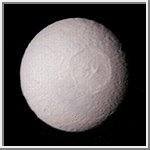|
COMETS EARTH JUPITER KUIPER BELT MARS MERCURY METEORITES NEPTUNE OORT CLOUD PLUTO SATURN SOLAR SYSTEM SPACE SUN URANUS VENUS ORDER PRINTS
PHOTO CATEGORIES SCIENCEVIEWS AMERICAN INDIAN AMPHIBIANS BIRDS BUGS FINE ART FOSSILS THE ISLANDS HISTORICAL PHOTOS MAMMALS OTHER PARKS PLANTS RELIGIOUS REPTILES SCIENCEVIEWS PRINTS
|
Related Document
Download Options
Early in the history of Saturn's moon Tethys, an impact occurred forming an enormous 400-kilometer impact basin named Odysseus. The impact scar spans more than two-fifths of the satellite with a diameter slightly larger than Saturn's moon Mimas. When Odysseus was first created, the crater must have been deep with a high mountainous rim and towering central peak. Over time the crater floor relaxed to the spherical shape of the Tethys' surface, and the crater's rim and central peak collapsed. (Similar relaxation is apparent on Jupiter's moons Callisto and Ganymede.) At the time of the Odysseus impact, Tethys must have been sufficiently warm and malleable to allow the topography to collapse. Tethys' interior may have even been liquid. If Tethys had been colder and more brittle at the time of impact, the moon may have been shattered. If it survived the impact, the topography of the crater would have retained its shape similar to Herschel crater on Mimas. This image was taken by the Voyager 2 spacecraft on August 25, 1981 from a range of 1.1 million kilometers (670,000 miles). |
||||||||||||||||||||||||||||||
